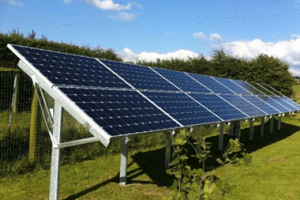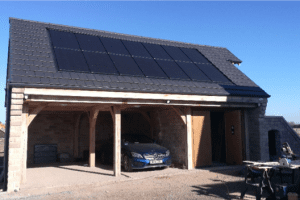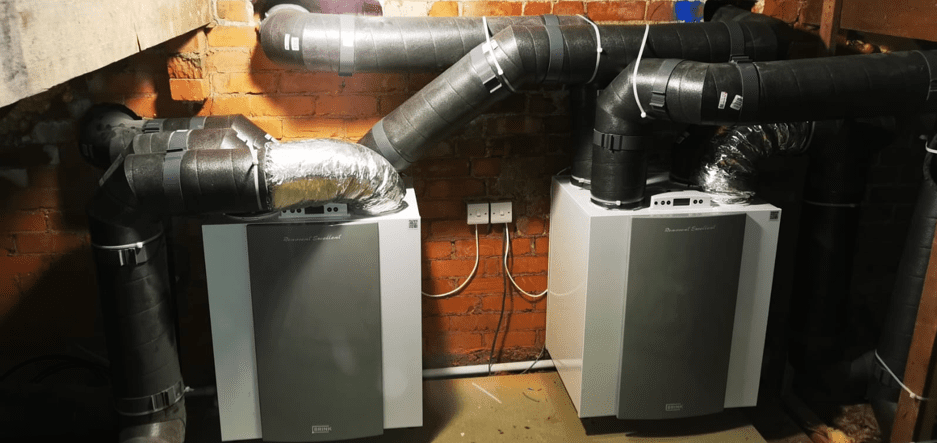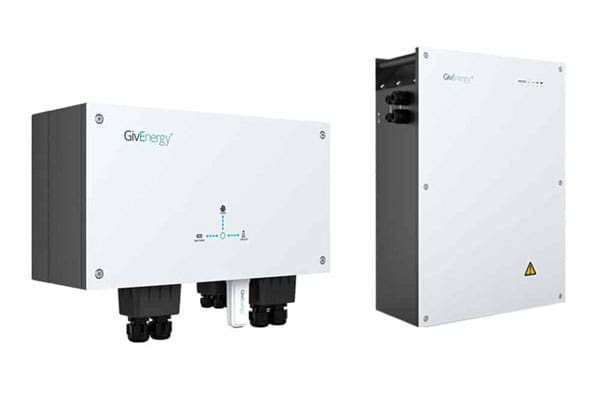Solar Photovoltaic (or PV) panels capture solar energy to generate electricity which can be used to power appliances in the home or business, stored in a battery for later consumption, or if no immediate demand fed into the national grid for which you will be entitled to a payment by your energy provider.
There are a variety of ways in which solar PV panels can be installed; on-roof and in-roof options and ground-mount systems where no suitable structures are available. The primary consideration for a successful installation is that an array is unshaded and has a general southerly aspect.
To maximise solar exposure arrays are commonly mounted on pitched roofs, preferably with a southern unshaded aspect. Commonly these are “on-roof” installations where the panels are fixed to the structure of the building by means of an aluminium frame set above the weathering surface – this form of system is used typically for retro fitting to existing roofs.
For new build or property renovations, an alternative is to opt for an “in-roof” array, where PV panels can be set within in trays/flashing around which tiles or slates are fixed to give a unified appearance improving aesthetics.
There are numerous systems available for mounting panels on flat or shallow-pitched roofs suitable for larger commercial installations. Many of these are secured by ballast preventing any need to breach the weathering surface of the roof.
Where no suitable roof areas are available, solar arrays can be “ground mounted” for which there are numerous mounting options depending on site specific characteristics.
Financial Benefit of Solar PV
Whether you are a domestic consumer or commercial organisation, using self-generated electricity from a solar PV array will reduce both your carbon footprint and your energy bills. Under the Smart Export Guarantee (SEG) scheme, you will also receive a payment from your chosen energy supplier for any surplus electricity that is not self-consumed and exported to the grid.
To qualify for the SEG your solar PV install must be undertaken by an MCS accredited company, which we are, and have a Smart Meter to record the amount of electricity exported. Every energy company is able to set their own SEG tariff which can range significantly between suppliers. Depending on the amount of surplus electricity likely to be exported and if the solar PV installation includes a battery the level of the SEG tariff will impact on the pay-back period.
Other Benefits of Solar PV
Sustainability is increasingly important in all aspects of the built environment. A PV system will improve the SAP calculations for new-build properties and the EPC rating for existing homes. From April 2025, the minimum rating required for residential properties offered to let will be raised to a “C” from the current “E” – this difference could potentially equate to a 3.0kW solar PV installation.
For commercial, agricultural, and other non-domestic organisations, there are additional benefits of installing solar PV which can help significantly in achieving ISO 14001 accreditation, demonstrating corporate social responsibility and meeting green credentials which are now often required in contract tenders.
Solar PV compliments and integrates easily with other energy saving technologies such charging electric vehicles or powering heat pump systems. generating heat and hot water for homes and businesses.
Planning Permission and Other Considerations.
Solar panels for the majority of installations under 50kWp output are Permitted Development and do not require planning consent. There are some exceptions to this rule e.g. where panels project more than 200mm above the roof line, for listed properties or those in sensitive areas such as Conservation areas, National Parks or AONB. Ground mounted systems, larger than 9m² (subject to conditions) will require planning permission. Any systems over 50kW will require approval from the Local Planning Authority.
Consent from the DNO (District Network Operator) is required to connect installations of over 3.68kW peak output on a single phase supply, and 11kW for three phase. In these cases the DNO may make a charge for the network upgrade works.
In some cases a structural survey of your roof may be required to make sure it can copy with the weight and wind load of the panels.








